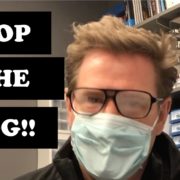How To Prevent Fogging of Your Glasses when wearing a Mask
With many more people wearing masks you are eventually going to have to deal with fogging up glasses. I’m Dr Michael Nelson and today we are talking about fogging up glasses. Good Optometry Morning.
So more people are wearing masks and this can cause a problem. Fogging up lenses that you are trying to see through. So as these ads clearly tell us..this is a problem for doctors, but more importantly it can be a problem for you…just look…what if you were slicing veggies and couldn’t or what if you were running a race and you mistake a crime scene for the finish line.
Weather it’s your glasses, the oculars on your microscope or the phoropter. Today I am going to share tips on how to minimize these glasses and make sure you wait till the end because I have a great entrepreneurial idea for someone that wants to develop a new product. Oh and if you like this type of video don’t forget to like, subscribe and comment.
So before we we go any further lets understand what causes the fogging. Fogging is caused by a condensation for warm air on a cool surface. So basically your breath is warm and when it comes in contact with your cool glasses then it condenses on the lens. Now the really important thing is how the water condenses. Most eyeglasses lenses are designed to by hydrophobic means they repel water and it forms a bead and then it rolls off. So when your breath condenses is forms a bunch of microscopic beads of water and each of these beads of water act like a clear lens that bends light in some random pattern and as a result you can’t see through it. And that is what fogging is.
To most of us wearing masks is new….but we should remember this is not a new problem. There is a group of people that have been dealing with this problem for a century. Surgeons. And they wear glasses and use microscopes. So let’s see what they have say. There are three
Suggestions from published articles: All published in the Annals of the Royal College of Surgery.
Number 1: they wearing 2 masks. 2000 Annals of Royal College of Surgery: whear two masks
A different article suggest applying tape or double sided tape along the top of the mask. 2006: tape/double sided tape on around nose
And a third suggest a novel way to tie the mask. 2014 novel way to tie the facemask
Now I am not a surgeon so I don’t have any first hand experience here but basically all of these methods are trying to prevent your breath from escaping out the top of the mask and reaching your glasses. So the basically make sure the fit on the upper part of the mask is good and that should help a lot.
[Developing and Testing of the Mask The development of the mask goes back to 1899, when Flügge, who was working at that time with tuberculosis, developed the droplet theory of infection. At that time crude masks were used, consisting of roller gauze strips placed over the mouth.1Hamilton2 published a paper in 1905 dealing with the dissemination of the Streptococcus through the “invisible sputum.”]
Okay so if we just pay attention to the fit , or stop breathing, you can minimize fogging. But is there anything you can do to the glasses themselves that can minimize fogging. And yes there is. So let’s go back to physics. I said before the problem was that the lenses are hydrophobic so water beads up on them…what if you could make the surface hydrophilic so that is so attracted to the lens that instead of forming beads of water it forms a uniform thin film on the surface that is allows light to pass through. This is a Surfactant effect
So here are some possibilities:
First: Another suggestion from the Annals of the Royal College of Surgery was to you wash you glasses with soapy water then then shake them off and let them air dry.
Second: is a tip used by lots of hockey players for their visors is to take shampoo or detergent straight on the lens, and then not use water, but just wipe it until clear.
A third option which I feels works the best is use a specific type of lens coating that is designed to have a surfactant effect. So half of this lens has an anti-fog lens coating and then it comes with special lens clothes that are impregnated with molecules that activate this coating to have even more of a surfactant effect. [this lens is Opti-Fog made by Essilor] This is a great option to consider when you are purchasing new glasses, but what do you do if you are not getting new lenses. So I thought of a fouth idea.
What if you just use these special activating clothes on a regular lens…will that give some effect?
Alright so there are great tips and as promised I have an business idea for someone in our industry. Why don’t you coat the coat the lenses in the oculars of the microscopes and the lenses in back of the phoroptor with an anti-fog coating. So I want someone do make that and when you do, remember is w=as my idea so I need you need to send me a prototype. And with that I wish you a Great optometry day.





Leave a Reply
Want to join the discussion?Feel free to contribute!